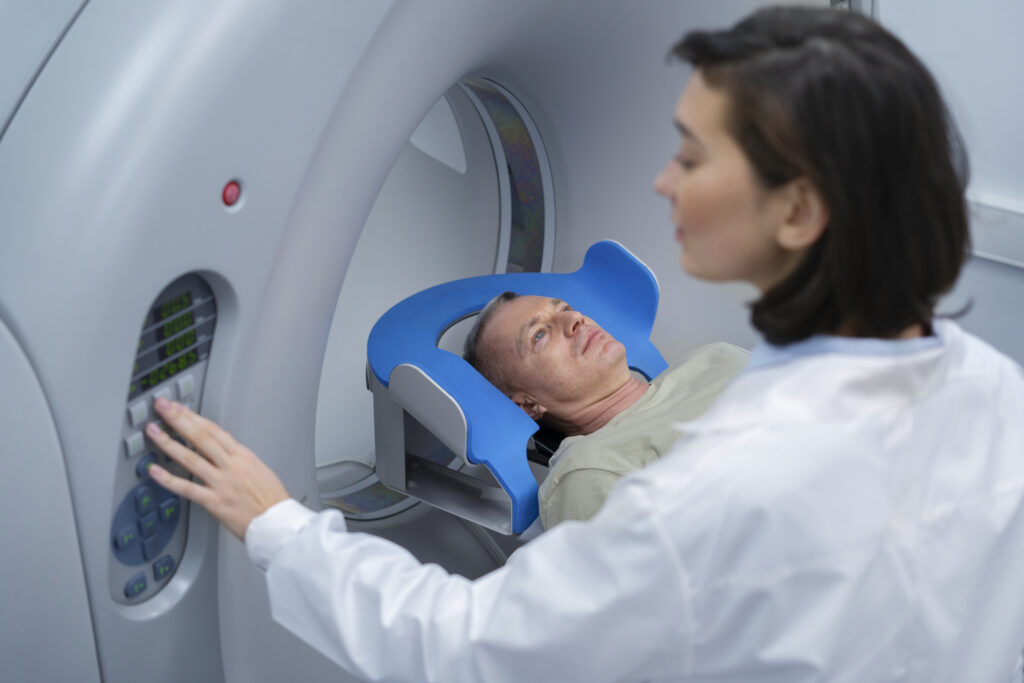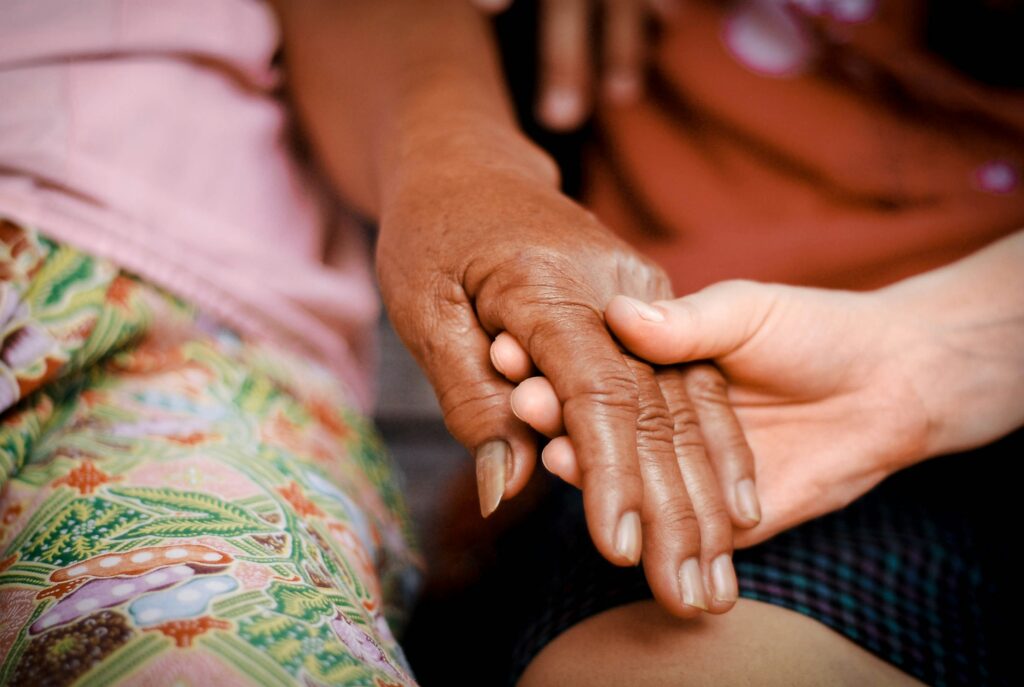Navigating PTSD After Cancer Treatment

Receiving a cancer diagnosis is an earth-shattering experience on its own. Add to that the constant poking of needles, patiently holding still for scans, and waiting for test results, and it’s easy to see how these experiences can take a toll on your emotional and psychological well-being. While the illness manifests on a physical level, the true battle is much deeper. It’s not just the body that’s impacted; your whole being walks this path. Post-Traumatic Stress Disorder (PTSD) is a very real side effect of cancer treatment I vividly remember my reaction to a simple word my yoga teacher used during meditation, a word that triggered old fears and physical sensations. She said: “Scan your entire body!” Even years after my diagnosis and treatments, certain words, images, and even smells take me back to that hospital environment— a time in my life when everything felt out of control like my world was spinning and I had nothing to hold onto. While medical staff tried to be compassionate and supportive, they were not walking this journey with me—I was. The term PTSD is often associated with military soldiers returning from combat, having experienced violence. But facing a life-threatening diagnosis is, in many ways, the beginning of a different kind of battle. The violence comes in a different form, through invasive and aggressive treatments like chemotherapy, radiation therapy, and surgery. Surgery, in particular, disrupts the body’s internal energy. Our bodies were not meant to be opened or poked—if they were, we would have been made with doors and windows like a house. A body needs harmony and peace to function in a healthy way. When I reacted to my yoga teacher that day, I realized that my scars—both physical and emotional—had not fully healed. I needed to give myself more time and care to find peace within my body. I began paying closer attention to my daily thoughts: What thoughts had become a permanent part of me? Were they fearful, filled with worries about my body? Did I fear losing my loved ones to disease or tragedy? How could I quiet these thoughts and reach a more peaceful mind? Having a regular meditation practice and calming my mind through breathwork helped to some extent, but I realized that these thoughts had taken root over time, and I needed to dig deeper. I began reframing my visits to the doctor and follow-up tests. Instead of recalling past fears, I started reminding myself that I was in control of this journey. I now approach every appointment as a step toward healing. If I stay home and avoid appointments, I risk the possibility of the disease returning. But by showing up, I am choosing to take charge and do what I can to help my body. I also allowed myself to talk openly about my journey in safe spaces, with friends and support groups who were ready to listen. Every time I shared my story, I felt I healed a little more. I stopped hiding my fears—about the future and even the present. I let go of the guilt I felt for surviving when some of my friends had not. I accepted that this journey is uniquely mine. While the medical staff focused on the physical aspects of my recovery, I knew it was crucial to address my emotional and psychological well-being as well. Returning to my regular routine wasn’t easy. I felt lost. I had been away on a long, transformative journey, and now everything felt different. How could I return to the life I had known? The word “normal” didn’t quite fit anymore. I had to create a “new normal” for myself, carrying this new set of experiences into this next phase of life. I knew time would allow me to gradually figure out the steps to recovery. I also realized I had to be more flexible than ever before to deal with my new mental state. My mind, which needed more attention and care than before, had to be treated gently. I needed to be kind to myself as I helped my mind heal. Consistency and discipline became important as I worked to establish a new routine. I realized that my body was no longer the same as it was before cancer treatment. What I had once been able to do, physically, was no longer possible. Shorter exercise routines, fewer social gatherings, and carving out solitude for self-care became my new normal. I stayed in touch with fellow cancer patients who were going through similar treatments. I didn’t want to mask the reality of my experience but wanted to face it in a healthier way, with a fresh perspective. I no longer wanted to feel anxious every time the phone rang from my doctor’s office or when I approached a hospital building. Meeting with some of my cancer recovery friends once a month reminded me that I wasn’t alone in my thoughts or feelings. I just had to be more mindful and not feed into the negative narratives my mind wanted to create. I know that healing takes time, and the journey is a roller coaster of emotions. PTSD symptoms may stay with me for the rest of my life, but how I react to them is what matters most. I accept them with love but refuse to give them the power to control me. My PTSD is a real struggle, but healing is possible, and I will not give up on my mind. Nameste, Shab
The Tough Decisions Caregivers Face

After coming to terms with my father’s cognitive decline, my brother and I were confronted with a harsh reality: home was no longer a sustainable option. The house that had been a place of comfort and memories was now a source of stress, risk, and growing uncertainty. As much as we wanted to hold on, we knew that waiting too long to make a change could leave us with fewer and less desirable options for his care. One of the biggest concerns we faced was the need to transition him into an Assisted Living facility before his cognitive state declined further. Many Assisted Living facilities have requirements—if a resident’s cognitive impairment progresses beyond a certain point, they may be moved to Memory Care. While Memory Care provides necessary supervision, it often comes with more restrictions, less independence, and a very different living environment. We wanted our father to have as much autonomy and dignity as possible for as long as possible, and that meant making a move sooner rather than later. Selling his home was one of the most difficult and emotional steps in this process. This was the house where we grew up, where birthdays were celebrated, where countless memories were made. Sorting through his belongings felt like peeling back layers of our family history, each item a reminder of the life he had built. The logistics of preparing the house for sale—coordinating with real estate agents, dealing with legal paperwork, and handling the emotional weight of it all—was overwhelming. Through it all, my brother and I leaned on each other. There were moments of frustration, disagreements over the best approach, and nights filled with exhaustion. But we both knew that at the heart of every decision was our father’s well-being. We had to put aside our emotions and focus on what was best for him. The process of searching for an Assisted Living facility was another daunting task. We toured multiple places, each with its own set of strengths and weaknesses. We had endless questions—how involved was the staff? What was the community like? Would our father feel at home? It was a delicate balance between finding a place that met his needs while also feeling like a place he could comfortably transition into. There were no easy answers in this journey. Every choice felt like a compromise, a trade-off between what we wished could be and what reality demanded. But as difficult as these decisions were, we knew we had to make them with courage and urgency. In the next post, I’ll take you through the search for the right Assisted Living facility—the questions we asked, the challenges we faced, and the moment we knew we had found the right place for our father to call home.
A Radiation Therapist’s Perspective

As a former Radiation Therapist, I was a witness to countless patients and their journeys through cancer treatment. I often wondered about the profound changes the psyche endures. Cancer enters our lives uninvited—sometimes creeping in silently, other times crashing in like a storm. It affects not only the body but shakes our very foundation. Emotions swirl, and the world looks different in the blink of an eye. Fear and anxiety rise to the surface, isolation feels like the safest refuge, and self-sabotage emerges as a coping mechanism. Fear is often the first reaction when receiving a diagnosis. The mind races, filling in the blanks with worst-case scenarios. Questions come up: What does this mean? How will this change my life? Will I survive? Will I lose my hair? What about my family? At its core, fear is the mind’s way of trying to protect us, yet more often, it amplifies suffering. Anxiety follows closely behind, trapping thoughts in an uncertain future. Anxiety does not understand the concept of now. And so, a new cycle begins—this becomes the new normal. I remember listening to my patients as they tried to make sense of their illnesses. Many sought answers—Was this a punishment from God? Did my lifestyle contribute to this? Is this a lesson? What have I done wrong? What choices led me here? While I could see their fear and anxiety, I also sensed an unspoken urgency—to slow down, to acknowledge life as it was unfolding. Take it one day at a time. Feel life. I observed an evolution when self-compassion emerged. Patients became gentler with the changes their bodies were undergoing. Instead of resenting their symptoms and pain, they worked alongside them. The need to control every aspect of their medical situation softened, trust took over, and the process seemed to flow more smoothly—guiding them from one phase to the next. When I had the privilege of treating a close friend and former colleague, I witnessed a drastic shift in the psyche. She walked in for her daily treatments, barely saying a word. The weight of her withdrawal was palpable. A former healthcare professional, now facing the same challenge she had once helped others navigate. In her mind, no one truly understood what she was going through. Her ego was crushed. Not even the colleagues she once trusted could save her. Life around her continued as usual, while hers had come to a halt. She felt isolated. Isolation became her shield—a way to preserve energy when everything else was falling apart. I gently tried to bridge the gap, not just as her therapist but as a friend. I reminded her that the support surrounding her was not judgment but a safety net—a place to lean on without guilt. But in those moments, I don’t think she heard a word I said. Sometimes, all it takes is one person—a single presence offering true understanding—to help ease the burden of fear and anxiety. I know from personal experience that illness can feel incredibly lonely, but the presence of a loved one or a friend brings immense comfort. Reaching out requires courage and patience on both sides. Family and friends should not be discouraged, nor should the patient walk this unbearable path alone. In reaching out, we remember that we are not alone—that we are capable of loving and of being loved, if only we crack the door open to let the light in. While isolation often felt like a prison for my patients, self-sabotage was the guard at the door. When illness disrupts life, this response can emerge unexpectedly. I recall one patient confiding in me about his refusal to follow his doctor’s recommendations. “What has my body ever done for me? Look how it’s repaid me for all my good behavior,” he mocked. He had decided to neglect his health entirely, convinced he was undeserving of healing. He pushed his family away, believing they would only remind him of his illness and deepen his pain. I had seen this rebellion before. For some, it feels easier to lean into despair than to hold onto hope. After all, if you expect nothing, you cannot be disappointed. Especially when the future feels uncertain. As a Radiation Therapist, I made it my mission to be fully present for my patients. Even in their darkest moments, I dealt with patterns of self-sabotage with kindness rather than judgment. I created a safe space where true healing could happen despite their unwillingness to cooperate. I have witnessed the incredible strength of the human spirit. Not only did my patients endure, but they also transformed. They healed—sometimes in ways beyond the physical. Every breath became a reminder that life continued, even when it felt like it was slipping away. Cancer undoubtedly alters the course of one’s life, but it does not define who we are or who we will become. Beneath fear, anxiety, isolation, and self-sabotage, there is strength, wisdom, and an unbreakable connection to something greater than us. My patients are never truly alone. They remain in my heart and my thoughts—always. The psyche may change, but the essence of who they are remains unshaken. Namaste, Shab.
The Bittersweet Reality of Recovery

When my father was diagnosed with Stage 4 lymphoma, our focus was singular: survival. Every decision, every exhausting day, was centered on getting him through treatment and keeping hope alive. Against the odds, he emerged on the other side—his body growing stronger, his cancer in remission. For a brief moment, we thought we had won. What we didn’t anticipate was that recovery would come with a different kind of battle, one we weren’t fully prepared to fight. While my father’s physical condition improved, his cognitive function declined. At first, it was small things—forgetting appointments, struggling to find the right words. But as time passed, the signs became harder to ignore. Conversations became repetitive, his problem-solving skills weakened, and tasks that once seemed simple for him became frustrating obstacles. The man who had once handled his own affairs with ease was now struggling with confusion and memory gaps that were only getting worse. This new reality placed an unexpected and immense strain on me and my brother. We had adjusted to being his caregivers during his illness, but this was different. The needs of a recovering cancer patient are one thing; the needs of a cognitively declining parent are another. There was no clear roadmap, no defined treatment plan, just a slow but steady loss of the father we once knew. Every decision now carried a new weight—one we had to navigate carefully and quickly. The hardest part was the realization that he would never return to full independence. We had held onto the hope that, once cancer was behind him, he could reclaim the life he once had. Instead, we were met with the sobering truth that this next stage would require even more from us as his children. It was a shift from crisis mode to long-term caregiving, and it came with a sense of loss we hadn’t been ready to face. As we stood at this crossroads, one thing became clear: we needed a plan, and we needed it fast. The question was, how do you prepare to take the next step when you’re still grieving the life your parent is losing? In the next post, I’ll share the difficult decisions my brother and I faced as we realized that home was no longer the safest place for our father—and the emotional weight of accepting that reality.
Understanding the Process and Benefits of Radiation Therapy

Last week, we discussed the importance of building trust with your radiation therapist and how it creates a supportive foundation for your treatment journey. Equally important is understanding the educational role your therapist plays in helping you navigate the complexities of radiation therapy. This week, we’ll explore how your radiation therapist ensures you’re well-informed about the process, empowering you to take an active role in your care. Demystifying the Radiation Therapy Process Radiation therapy is a highly specialized form of treatment, and it’s natural to feel uncertain about what it involves. Your radiation therapist is there to guide you through each step, ensuring that you have a clear understanding of the procedure. From the initial simulation session, where the treatment area is mapped out, to the precise delivery of radiation, your therapist will explain what’s happening and why it’s necessary. For example, your therapist might discuss how advanced imaging technologies are used to pinpoint the exact location of cancer cells, minimizing exposure to surrounding healthy tissue. They’ll also explain the role of immobilization devices, such as molds or masks, which help you maintain the same position during each session for optimal accuracy. This transparent communication helps build trust and makes the treatment process less intimidating. By knowing what to expect, you can approach each session with greater confidence and ease. Understanding the Benefits of Radiation Therapy Radiation therapy is a powerful tool in the fight against cancer. Your radiation therapist will help you understand how it works to target and destroy cancer cells. Unlike chemotherapy, which affects the entire body, radiation therapy focuses on a specific area, delivering high doses of radiation to shrink tumors or eliminate cancerous cells. Your therapist will also explain how radiation therapy fits into your overall treatment plan. For many breast cancer patients, radiation is used after surgery to reduce the risk of recurrence by targeting any remaining cancer cells in the breast, chest wall, or nearby lymph nodes. It may also be combined with chemotherapy or hormonal therapy to improve outcomes. Hearing these benefits directly from your therapist can ease concerns and reinforce the importance of completing your prescribed treatment plan. It’s a reminder that every session is a step toward recovery. Preparing for and Managing Side Effects Another key aspect of your radiation therapist’s role is educating you on what to expect during and after treatment. They’ll discuss common side effects, such as fatigue, skin irritation, or changes in breast texture, and guide how to manage them. For example, they might suggest specific skincare routines to minimize irritation or recommend strategies for conserving energy during treatment. Your therapist will also inform you about potential long-term effects, so you’re aware of what to monitor in the future. They’ll advise you on when to reach out to your medical team if you notice any unusual symptoms, ensuring that any complications are addressed promptly. Empowering You Through Knowledge By equipping you with information, your radiation therapist empowers you to take an active role in your treatment. This knowledge not only reduces fear but also fosters a sense of partnership between you and your care team. Understanding the “why” behind each step helps you feel more in control of your journey, making the experience more manageable. Your therapist will encourage you to ask questions and share concerns throughout the process. Whether you’re curious about how the equipment works or worried about potential side effects, they’re there to provide answers and reassurance. This open dialogue creates a collaborative atmosphere, where your voice is valued as part of your care team. Looking Ahead As we continue to explore the multifaceted role of your radiation therapist, next week we’ll focus on the emotional support they provide. Beyond their technical expertise, radiation therapists are compassionate listeners who can help you navigate the emotional challenges of treatment. Their presence and empathy are invaluable, ensuring you feel supported every step of the way.
The Mirror Talks Back

What we do every day counts! How many times have you heard this phrase? I’ve seen and heard it countless times, but I never truly understood its essence. It’s essentially telling us that our daily routine sets the foundation for how our body and mind respond. From the personal hygiene rituals in the morning to the bedtime prep, every cell in our body is listening and reacting. The mind that we often refer to and point to in our heads actually exists in every cell of our body. When we look at ourselves in the mirror and experience negative thoughts, our liver cells, stomach cells, and every part of us are listening too. What we tell ourselves doesn’t just circulate in our heads but travels throughout our body, just like blood circulation. After cancer treatments and multiple procedures, I could only see what I had lost: a breast, a limb, my hair, my eyebrows, my clear skin, and my once beautiful body shape. Body image after cancer is not an easy subject to address or navigate alone. During chemo, I gained twenty-five pounds and had a hard time even recognizing myself. Who was that person in the mirror? The facial hair I used to complain about was now gone, and I missed it. My once slim and attractive figure now resembled the Pillsbury Doughboy. The flexible joints that made me look like a ballerina were now stiff and achy, reluctant to move. Going through cancer treatment isn’t for the faint of heart; I get that now. But what does that say about me? It tells me I’m resilient. I’m still here, fighting, taking life one day at a time, and moving forward. If I look back too much, I might shatter. It’s hard to believe what I’ve endured. If someone had told me that weekly chemo and endless blood tests would become my norm, I’d have wanted to give up before even starting. But what I didn’t realize was just how much I wanted to live. I want to see my children grow up, witness their successes, and live a healthier life myself. Not that I was unhealthy before, but there’s always room for improvement. Maybe I can adjust my thinking, declutter my home to create space to breathe or react to life with more calmness. These are small changes, but they can make a big difference. It’s hard to motivate myself to move after what my body has been through. Asking it to get up and walk daily feels like asking the impossible. If my body could talk, it would probably say, “Are you kidding me? You want me to do what now?” I get it. It’s easier to stay on the couch and binge-watch Netflix. It’s easier to avoid cleaning the kitchen or taking a shower. But as tempting as it is to stay in that comfort zone, I know I still have today—and today is an opportunity. So, I get up slowly and savor my morning drink. I take a quick shower, enjoying the massage I’m giving my tired skin. When the sun is out, I put on my walking shoes and hat, grab my walker, and head outside for a stroll. The fresh air and changing seasons remind me of life’s constant evolution. If the trees can let go of their leaves and wait for new ones, why can’t I embrace change too? My curly hair may not return, but maybe I can experiment with straight hair. My slim figure might not be back yet, but my walks might help me shed some pounds and regain strength. My missing breast will always be a loss, but there are ways to feel semi-normal on the surface. How I feel within, however, will take time to heal. I’ve decided to focus on small improvements. Progress isn’t always linear; sometimes, it’s two steps forward and one step back. But that’s okay. My goal is to live each day with better habits and a more positive mindset. One thing I’m certain of is that blaming my body or myself for my cancer isn’t the way to go. Instead, I’m replacing negative and fearful thoughts with encouraging words before they spread through my body. My daily routine matters more than ever, and what I do every day counts tremendously in shaping my health and happiness. So, what are you waiting for? Ask yourself: what change could make the most difference in your life right now? Start small, and let each step lead you closer to healing and hope. Namaste, Shab
The Radiation Therapist’s Role in Patient Support

Last week, we discussed the benefits of mindfulness techniques for managing stress and emotions during treatment. This week, we’ll focus on an equally vital aspect of your care: the role of your radiation therapist in building trust and creating a supportive environment throughout your treatment journey. Radiation therapists are integral members of your healthcare team. From your first session to your last, they are there to ensure your treatment is delivered safely, accurately, and effectively. However, their role extends far beyond the technical aspects of treatment. They play a crucial part in making you feel comfortable, heard, and cared for during what can be an emotionally and physically challenging time. The Importance of Building Trust Building trust with your radiation therapist is essential for a positive treatment experience. Trust allows you to feel confident in their expertise, helping to alleviate anxiety and enabling open communication. When you trust your therapist, you’re more likely to share concerns or discomforts, which can lead to adjustments that improve your overall comfort and care. According to the American Society for Radiation Oncology (ASTRO), effective communication is a cornerstone of building this trust. A compassionate therapist will take the time to explain each step of the treatment process, from positioning on the treatment table to the specific goals of the radiation therapy. They will also encourage you to ask questions, no matter how small, and address your fears with patience and empathy. Emotional Support During Treatment Radiation therapy can feel intimidating, especially during the early sessions. Your therapist is there to provide reassurance and emotional support, helping you navigate these feelings. They understand that each patient’s journey is unique and strive to create an environment where you feel safe and cared for. For example, if you’re feeling anxious before a session, your therapist might guide you through relaxation exercises or use calming language to help ease your nerves. These seemingly small gestures can make a significant difference in your overall experience, transforming a potentially stressful situation into one that feels manageable and even empowering. Practical Support and Comfort Radiation therapy often involves multiple sessions over several weeks, making physical comfort a priority. Your therapist is responsible for ensuring you’re positioned correctly on the treatment table, but they’ll also take steps to make you as comfortable as possible. If you experience discomfort, such as pain or difficulty holding a specific position, your therapist can make adjustments or suggest strategies to improve your comfort. In addition, your therapist is a valuable resource for managing side effects. Whether it’s offering advice on skincare for radiation-treated areas or suggesting ways to reduce fatigue, they are there to provide practical guidance that supports your well-being. Creating a Collaborative Relationship The relationship between you and your radiation therapist is a partnership. By being open about your concerns and asking questions, you allow your therapist to better meet your needs. In turn, their attentiveness and dedication help foster a sense of collaboration and mutual respect. This partnership not only enhances your treatment experience but also contributes to better outcomes by ensuring your care is tailored to your unique circumstances. Building a Supportive Environment Your therapist understands that the treatment process can be overwhelming, and they are committed to creating a supportive environment. This might involve providing a consistent routine that helps reduce uncertainty, offering encouraging words, or simply listening when you need to talk. Their presence can be a source of stability and comfort during a time of change and challenge. Next week, we’ll explore another important aspect of your therapist’s role: educating you about the radiation therapy process. Understanding how radiation therapy works and the benefits it provides can help you feel more empowered and engaged in your treatment journey.
Healthcare Interactions Impact Patient Safety

I’ve been researching, teaching, and writing about the importance of communication skills and emotional intelligence for over 20 years. This is roughly the same amount of time that The Joint Commission has been tracking catastrophic mistakes we make which are known as Sentinel Events. They track and publish a detailed report on the types and causes of these tragic events including the most recent 2023 Annual Report. What is most striking is how communication is and has been one of if not the leading root cause year after year! And root causes of Sentinel Events that show up consistently in the data include teamwork, leadership, and human factors. We can appreciate how the quality of interactions influences our ability to provide safe care by examining two examples. Image by Gerd Altmann from Pixabay A nurse overhears a colleague gossiping about her and interrupts: “I’d appreciate it if you have concerns about my work that you discuss them with me directly and professionally.” The gossiping nurse apologizes and later offers to help the nurse. The help enabled the nurse to get pain medication to her post-op patient quickly and the patient felt cared for. Patient experience scores increase. A doctor yells at a nurse on Tuesday. Saturday night the nurse hesitates to call her about a subtle change in a patient’s condition. Since it’s close to the end of the shift, she tells the oncoming nurse. This nurse makes it a priority to check the patient, but the telemetry alarm beats him to it. The patient does not survive. These examples show how the quality of simple interactions influences critical outcomes like patient safety and patient experience. Like the ‘Butterfly Effect, in both these situations, the outcomes are obvious, yet the roots involving the quality of interactions are elusive. Combining this train of thought with the data suggests that our solutions to date are not getting at the underlying issues aimed to improve these root causes. Reducing the incidence of sentinel events will require us to dive deeper into the social and emotional learning that influences individual, team, and organizational behavior. This includes understanding the need for professionals to develop skills and competencies that influence the quality of our interactions. These include; self-awareness, confidence, adaptability, flexibility, perspective-taking, and the ability to give and receive constructive feedback, set limits, respect others’ limits, ask for help, and delegate tasks. Developing these skills is no small task as people have different levels of growing edges, resources such as time and money are limited, experiential learning opportunities are essential, and effective teaching methods are limited. The good news is that Medical Improv can be used to teach all of these skills and competencies while reducing stress and promoting positive relationships and cultures. More about that in future posts. For now, the important take-home is that the quality of healthcare interactions matters!
Hope in Healing – Inspiring Stories of Resilience During Treatment

Last week, we explored the vital role of family dynamics in supporting both you and your loved ones throughout your cancer treatment journey. This week, we’ll focus on an equally powerful aspect of recovery: hope. Sharing stories of resilience and triumph from individuals who have faced the challenges of breast cancer can inspire and motivate you as you navigate your own path. Hope is more than just wishful thinking—it’s a driving force in the healing process. It uplifts your spirits, fuels determination on tough days, and reminds you that you’re not alone. Stories of others who have endured similar struggles provide a source of strength and perspective, demonstrating that even in the darkest moments, resilience and growth are possible. Consider the story of Maria, who faced multiple rounds of radiation therapy and chemotherapy. Despite the physical and emotional toll of treatment, Maria chose to focus on maintaining a sense of normalcy. She continued to work, care for her children, and even volunteer in her community. Maria’s story is a testament to the strength that emerges when we embrace life’s challenges with courage and purpose. Another inspiring figure is Janice, who was diagnosed with advanced-stage breast cancer. Instead of retreating, she found a renewed sense of purpose by becoming an advocate for cancer awareness. Through her efforts, she educated others about the importance of early detection and offered support to newly diagnosed patients. Janice’s determination to make a difference not only helped her cope with her diagnosis but also created a lasting impact on her community. These stories highlight a common theme: while cancer treatment is undeniably challenging, it can also be a journey of personal growth and connection. Many survivors report discovering inner strengths they never knew they had, building deeper relationships with loved ones, and gaining a greater appreciation for life’s simple joys. Drawing hope from others’ experiences doesn’t mean ignoring the difficulties of your own journey. Instead, it’s about finding inspiration to keep moving forward. Whether it’s through a personal connection, a memoir, or a local support group, hearing how others have persevered can bolster your own resilience and remind you of the possibilities that lie ahead. For some, hope is also found in small, everyday victories. Completing a treatment session, feeling well enough to enjoy a favorite meal, or receiving good news from your medical team are moments worth celebrating. Recognizing and appreciating these milestones can reinforce your determination and keep your spirits high. Remember, hope doesn’t have to come from grand gestures or monumental achievements. It often lives in the quieter moments: a kind word from a friend, the laughter of a loved one, or the comfort of knowing you’re supported by your healthcare team. Next week, we’ll explore mindfulness techniques as another way to navigate the emotional challenges of treatment. These tools can help you manage stress, maintain a positive mindset, and find balance during this demanding time. Hope, coupled with mindfulness, can create a powerful foundation for emotional and physical resilience.
The Power of Compassion

My father and I had a close relationship when I was growing up. He was my protector and savior. I looked up to him for guidance and problem-solving until I became an adult. He watched me grow into an independent woman who no longer needed him in the same way. Over the years, as I became more successful and built a family of my own, something shifted. He began envying me. I often wondered why my father, who loved me dearly, wasn’t happy about my achievements. In the rush of life, I forgot the details of my childhood experiences with him. I believe I was unconsciously omitting what didn’t feel good and holding onto the idealized image I had created as a child. Everything became painfully clear when I had to care for him after his cancer diagnosis. His anger surfaced more vividly, and his old demeanor showed his true face. He was dealing with immense physical pain and depression due to his prognosis, but none of this justified the way he was treating me. The first time he yelled at me—because I had moved his glass of water from the counter to the sink—it triggered a flood of memories. His loud voice and negative comments hit me like a ton of bricks. As an adult, I suddenly felt like a five-year-old child again, unsure of how to deal with the emotional abuse. I found myself grappling with an impossible question: How do I balance compassion with boundaries? He was sick, after all. Should I walk away, knowing he needed care? Should I yell back and show him that I, too, could be as forceful as him? Or should I bring compassion into the space, ignoring my past experiences and the present unfair treatment? Wrestling with Inner Conflict My spiritual side was completely conflicted. I believed in treating myself with kindness and respect, yet here I was, enduring verbal abuse from someone I loved. This wasn’t the journey I had imagined for myself. Allowing even my father to mistreat me felt like a betrayal of my values. But how could I leave him when he needed me the most? I lost countless nights of sleep over this. By day, I felt as though I was walking on thin ice, learning to avoid topics that might annoy him. I adjusted to his flow of questions and concerns, keeping conversations shallow to avoid conflict. He was in his world, and I often became his emotional punching bag. Over time, I realized I needed to protect my well-being. I started reducing the hours I spent caring for him and allowed other family members and friends to step in. I made time for myself—treating myself to a massage or taking long walks in the park. I began journaling, reflecting on what went well each day, and releasing the negativity by attaching forgiveness to it. I reminded myself that one day, I would look back and cherish the small moments of quality time we shared, even amidst the challenges. Lessons in Compassion and Boundaries This chapter of my life taught me a profound lesson: compassion has its limits. It’s okay to say, “Not today, but maybe tomorrow.” Just because he was my father didn’t mean he had the right to mistreat me, especially when I was showing up for him wholeheartedly. Finding Support This type of situation is difficult and often embarrassing to share with friends or family. If your immediate circle cannot offer the support you need, consider joining in-person or online support groups. The last thing you want to do is store these emotions in your body, where they can act as poison. Let them out. Above all, remember that taking care of yourself is not selfish—it’s necessary. Compassion starts with yourself. Only then can you offer it to others without losing your peace. Namaste, Shab
